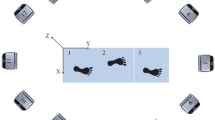Abstract
The human biped walking shows phase- dependent transient changes in gait trajectory in response to external brief force perturbations. Such responses, referred to as the stumbling reactions, are usually accompanied with phase reset of the walking rhythm. Our previous studies provided evidence, based on a human gait experiment and analyses of mathematical models of gait in the sagittal plane, that an appropriate amount of phase reset in response to a perturbation depended on the gait phase at the perturbation and could play an important role for preventing the walker from a fall, thus increasing gait stability. In this paper, we provide a further material that supports this evidence by a gait experiment on a biped humanoid. In the experiment, the impulsive force perturbations were applied using push-impacts by a pendulum-like hammer to the back of the robot during gait. The responses of the external perturbations were managed by resetting the gait phase with different delays or advancements. The results showed that appropriate amounts of phase resetting contributed to the avoidance of falling against the perturbation during the three-dimensional robot gait. A parallelism with human gait stumbling reactions was discussed.
Similar content being viewed by others
References
Collins S, Ruina A, Tedrake R, Wisse M (2005) Efficient bipedal robots based on passive-dynamic walkers. Sci Mag 307:1082–1085
Dimitrijevic MR, Gerasimenko Y, Pinter MM (1998) Evidence for a spinal central pattern generator in humans. Ann NY Acad Sci 860:360–376
Forner Cordero A, Koopman HJFM, van der Helm FCT (2003) Multiple-step strategies to recover from stumbling perturbations. Gait Posture 18:47–59
Forner Cordero A, Koopman HJFM, van der Helm FCT (2004) Mechanical model of the recovery from stumbling. Biol Cybern 91:212–220
Forssberg H (1979) Stumbling corrective reaction: a phase-dependent compensatory reaction during locomotion. J Neurophysiol 42(4):936–953
Grillner S (1981) Control of locomotion in bipeds, tetrapods, and fish. In: Brooks V (ed) Handbook of physiology. The nervous system II. Waverly Press, Baltimore, pp 1179–1236
Hirai K, Hirose M, Haikawa Y, Takenaka T (1998) The development of Honda humanoid robot. In: Proceedings of IEEE international conference on robotics and automation, pp 1321–1326
Kawato M (1981) Transient and steady state phase response curves of limit cycle oscillators. J Math Biol 12:13–30
Kobayashi M, Nomura T, Sato S (2000) Phase-dependent response during human locomotion to impulsive perturbation and its interpretation based on neural mechanism (in Japanese). Trans Jpn Soc Med Biol Eng (BME) 38(1):20–32
McGeer T (1990) Passive dynamic walking. Int J Robot Res 9: 62–82
Nakanishi J, Morimoto J, Endo G, Cheng G, Schaal S, Kawato M (2004) Learning from demonstration and adaptation of biped locomotion. Robot Auton Syst 47:79–91
Schillings AM, van Wezel BM, Mulder T, Duysens J (1999) Widespread short-latency stretch reflexes and their modulation stumbling over obstacles. Brain Res 816:480–486
Schillings AM, van Wezel BM, Mulder T, Duysens J (2000) Muscular responses and movement strategies during stumbling over obstacles. J Neurophysiol 83:2093–2102
Taga G (1995) A model of the neuro–musculo–skeletal system for human locomotion. Biol Cybern 73:97–111
Tsuchiya K, Aoi K, Tsujita K (2003) Locomotion control of a biped locomotion robot using nonlinear oscillators. In: Proceedings of IEEE/RSJ international conference on intelligent robots and systems, pp 1745–1750
Van der Linde RQ (1999) Passive bipedal walking with phasic muscle contraction. Biol Cybern 81:227–237
Vukobratovic M, Borovac B, Surla D, Stokic D (1990) Biped locomotion. Springer, Berlin Heidelberg New York
Winfree AT (1980) The geometry of biological time. Springer, Berlin Heidelberg New York
Yamasaki T, Nomura T, Sato S (2003a) Possible functional roles of phase resetting during walking. Biol Cybern 88:468–496
Yamasaki T, Nomura T, Sato S (2003b) Phase reset and dynamic stability during human gait. Biosystems 71:221–232
Author information
Authors and Affiliations
Corresponding author
Electronic supplementary material
Rights and permissions
About this article
Cite this article
Nakanishi, M., Nomura, T. & Sato, S. Stumbling with optimal phase reset during gait can prevent a humanoid from falling. Biol Cybern 95, 503–515 (2006). https://doi.org/10.1007/s00422-006-0102-8
Received:
Accepted:
Published:
Issue Date:
DOI: https://doi.org/10.1007/s00422-006-0102-8




